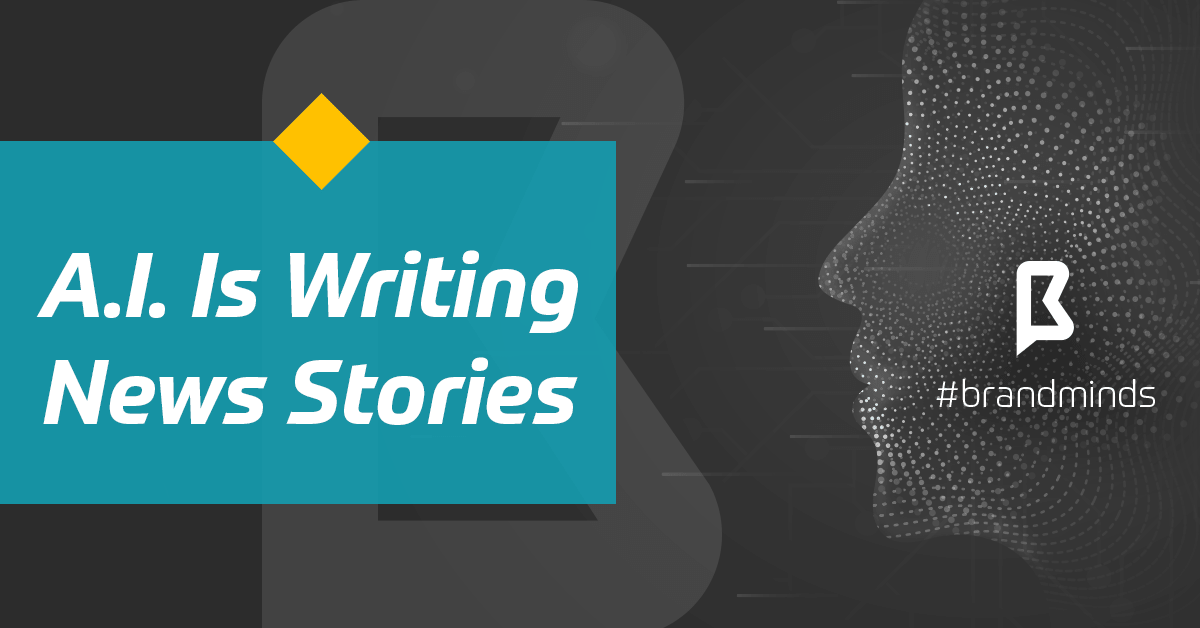Artificial Intelligence (AI) in Healthcare is Expected to Grow to $36.1 billion by 2025
According to Markets and Markets, Artificial Intelligence (AI) in healthcare is expected to grow from $2.1 billion in 2018 to $36.1 billion by 2025, at a CAGR of 50.2% during the forecast period.
That’s the highest growth percentage among the growing industries we have previously analyzed on this blog: pet-food (4,8%), gaming, health & wellness (12.8%) and health & fitness (10%).
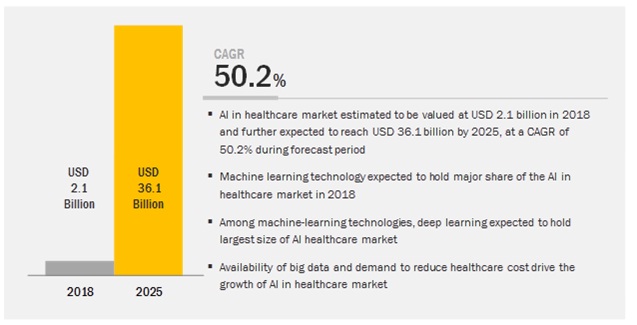
Source: marketsandmarkets.com
Topics:
- Reasons why Artificial Intelligence is disrupting the healthcare industry
- Artificial Intelligence in healthcare statistics
- Factors driving and limiting growth
- Artificial Intelligence applications in healthcare
- Examples of AI-powered apps
- Trends via CBInsights
- Big pharma partnerships with AI healthcare startups
Why is Artificial Intelligence disrupting the healthcare industry?
The reasons Artificial Intelligence is changing healthcare are quite obvious. AI is quicker and better than human doctors: the machine takes 15 seconds to read and diagnose scans while doctors arrive at a diagnosis in 30 minutes.
AI brings many benefits to the healthcare industry worldwide. Data-driven products and services result in cost cuts, treatment improvement, increased accessibility, higher-quality personalization and a more accurate initial diagnosis which leads to a more effective treatment plan.
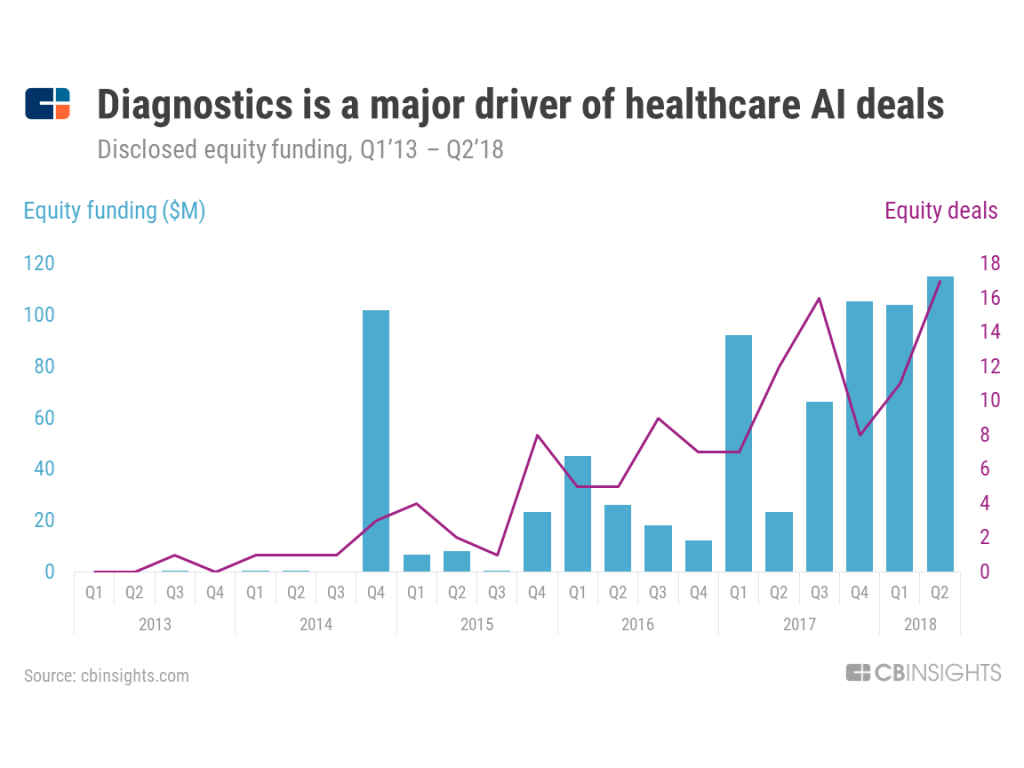
Artificial Intelligence in Healthcare Statistics
Between 2013 and 2017, more than 300 health care AI-related patents were issued with the following technology giants leading the charge: Alphabet filed 186 patents, Microsoft – 73 and Apple – 54.
Funding for U.S.-based AI and machine-learning health companies has increased more than 2,000% since 2011.
Factors driving the growth of Artificial Intelligence in healthcare
- increased number of artificial intelligence solutions;
- the ageing of baby boomers and prolonged life expectancies;
- advancements in clinical research;
- advancements in personal digital assistants;
- AI’s enhanced ability to reach an accurate diagnosis in the early stages of chronic diseases and disorders;
- increased funding in healthcare Artificial Intelligence;
- effective cost reduction in healthcare expenditures;
- the growing number of startups for AI in healthcare;
- the ability to share health information easily across institutions and software systems which is one of the most pressing issues in healthcare.
According to Healthcare Weekly, AI startups have raised $4.3B across 576 deals since 2013, topping all other industries in AI deal activity.
Factors limiting the growth of Artificial Intelligence in healthcare
- end-users’ reluctance to adopt Artificial Intelligence technologies;
- potential risks associated with Artificial Intelligence in healthcare;
- lack of trust.
Artificial Intelligence applications in healthcare
- appointment scheduling;
- insurance coverage checking;
- clinical imaging & diagnostics;
- developing new drugs;
- monitoring patients progress;
- precision surgery.
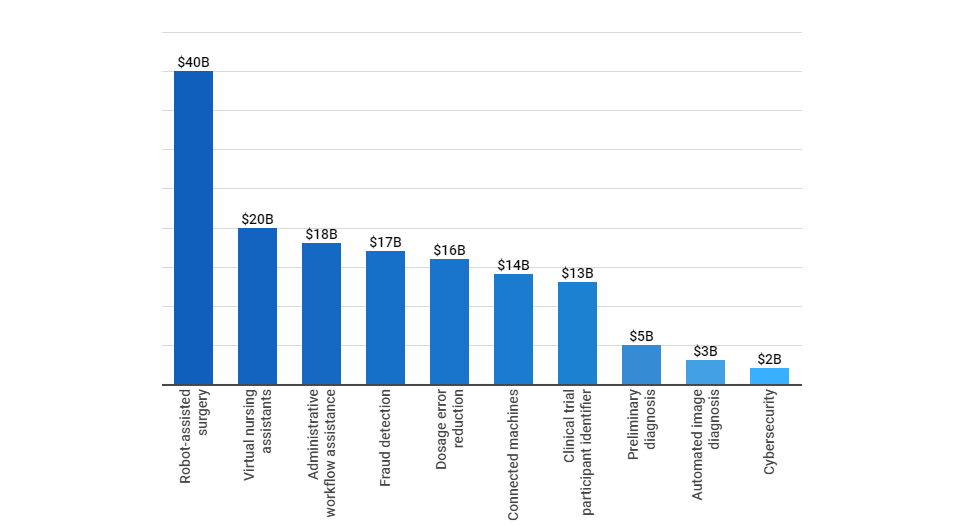
Source: forbes.com
AI-powered apps
Here, on the blog, we have talked about AI-based apps extensively.
Here are 3 healthcare apps developed on AI-based technology:
- the Child Growth Monitor built on Microsoft artificial intelligence solutions;
- Ginger.io, an app which offers professional coaching services to support employees’ emotional wellness;
- Replika, an app which helps users unlock their emotional intelligence.
7 Trends for AI in healthcare via CBInsights
1. AI-as-a-medical-device
Here are 3 AI software platforms which FDA has already approved:
IDx-DR is an AI software that screens patients for diabetic retinopathy without the need for a second opinion from an expert. The results are remarkable: it was able to correctly identify patients with “more than mild diabetic retinopathy” 87.4% of the time, and identify those who did not have it 89.5% of the time.
Viz.ai analyzes CT scans and notifies healthcare providers of potential strokes in patients. The company closed a $21 million Series A round from Google Ventures and Kleiner Perkins Caufield & Byers.
Arterys was FDA-approved last year for analyzing cardiac images with its cloud AI platform.
2. Using neural networks to identify the risk of heart disease
AI could potentially help identify the risk of heart disease. One algorithmic approach showed 85% accuracy in detecting diabetes from heart rate.
3. Building a clinical research ecosystem
With iPhone and Apple Watch, Apple is the first tech company to build a health records ecosystem. Since 2015, Apple has launched two open-source frameworks — ResearchKit and CareKit — to help clinical trials recruit patients and monitor their health remotely.
In January 2018, Apple announced that iPhone users will now have access to all their electronic health records from participating institutions on their iPhone’s Health app.
4. Traditional pharma companies looking to AI SaaS startups for innovative solutions
Big pharma companies have recognized the huge potential and the benefits AI can offer to healthcare.
Pfizer entered into a strategic partnership with XtalPi — an AI startup backed by tech giants like Tencent and Google — to predict pharmaceutical properties of small molecules and develop “computation-based rational drug design.”
5. Chinese investments in AI healthcare are on the rise
The Chinese government issued an artificial intelligence plan last year, with a vision of becoming a global leader in AI research by 2030. Healthcare is one of the 4 areas of focus for the nation’s first wave of AI applications.
Chinese big tech companies are now entering into healthcare AI with strong backing from the government. WeChat, Facebook’s competitor in Asia has reached 1 billion users. Also called the “app for everything”, WeChat reported 38,000 medical institutions had accounts last year, of which 60% allowed users to register for appointments online. Also, more than 2,000 hospitals accept WeChat payment.

6. DIY diagnostics
AI has turned smartphones and consumer wearables into powerful at-home diagnostic tools. Dip.io performs urine analysis via a smartphone camera and SkinVision monitors skin lesions and assess skin cancer risk.
7. Therapy bots
From life coaching to cognitive behavioural therapy to faith-based healing, therapy bots support users’ mental health and help them change negative thoughts and behaviours through conversations. Check them out: Woebot, Wyse, Tess, Sister Hope, WisdomBot etc.
Big pharma partnerships with AI healthcare startups
1.Pfizer partnered with XtalPi, a U.S.-China biotech firm that uses artificial intelligence and computing to accelerate the development of new drugs. XtalPi has raised a total of $67.6M in funding.
2. Merck partnered with Atomwise which develops artificial intelligence systems for drug discovery. Atomwise has raised a total of $51.3M in funding.
3. GlaxoSmithKline partnered with Insilico Medicine which develops high-performance AI platform for drug development to treat cancer and age-related diseases. Insilico Medicine has raised a total of $14.3M in funding.
4. Mayo Clinic partnered with Beyond Verbal which uses voice and AI to revolutionize healthcare, well-being and emotional Understanding. Beyond Verbal has raised a total of $10.1M in funding.
5. Novartis partnered with Pear Therapeutics to create software applications to treat patients with schizophrenia and multiple sclerosis. Pear Therapeutics has raised a total of $134M in funding.
6. Sanofi partnered with Recursion Pharmaceuticals which combines experimental biology, automation, and artificial intelligence to discover treatments. Recursion Pharmaceuticals has raised a total of $226.4M in funding.
7. Janssen Pharmaceutical partnered with BenevolentAI, an advanced technology company focused on accelerating the journey from data to medicines. BenevolentAI has raised a total of $202M in funding.
8. Roche Holding acquired Flatiron Health for $1.9B in February 2018. Flatiron uses machine learning to mine patient data.
Sources: healthcareweekly.com, cbinsights.com, forbes.com, fastcompany.com, crunchbase.com
Join the Conversation
We’d love to hear what you have to say.
Get in touch with us on Facebook Group and Twitter.
You can train an AI to fake UN speeches in just 13 hours
For less than $10, anyone can make an AI write a fake UN speech.
Check it out!
![]()
Learn more: This tool allows you to spot fake videos of real people
Join the Conversation
We’d love to hear what you have to say.
Get in touch with us on Facebook Group and Twitter.
A.I. Is Writing News Stories
This article is about three A.I.s writing stories for prominent publishers.
Communication is the act of conveying meanings from one entity to another through the use of mutually understood signs, symbols, and semiotic rules. There are two entities involved: the transmitter of the message and the recipient.
The rise of A.I. has changed how people communicate with each other. Google Duplex assists humans with scheduling certain types of appointments. The virtual assistant carries out conversations in a human-like voice essentially replacing the human transmitter of the message.
Does this mean we need to redefine the theory of communication to include a third entity of non-biological descent?
If the A.I. involvement with the spoken word is more easily accepted due to its fleeting nature, what about the written word?
Let’s see 3 A.I.s currently assisting prominent publishers:
2. Heliograf – The Washington Post
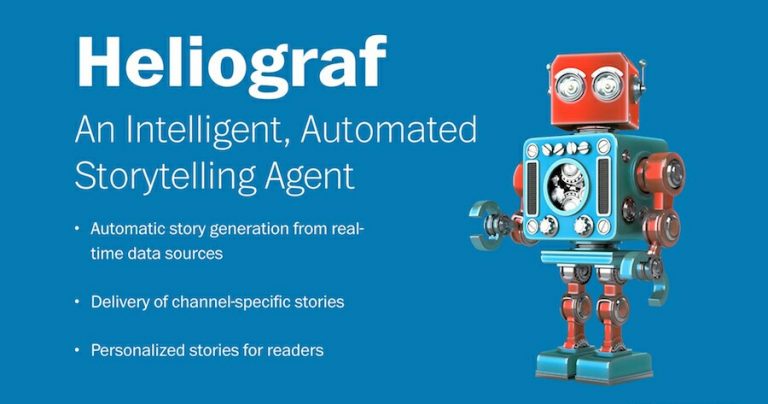
image source: blog.drhack.net
In 2017, the Amazon-acquired Washington Post began using A.I. to write articles. The writing A.I. is called Heliograf and began its writing career by creating pieces on the Rio Olympics, local sports and the election.
Within a year since the publisher started using Heliograf, the A.I. technology has produced 850 articles.
The purpose of Heliograf is to enable journalists to do more high-value, in-depth work, not to take their jobs.
Technology like Heliograf can be transformative for a newsroom, greatly expanding the breadth of coverage and allowing journalists to focus more on in-depth reporting.
Scot Gillespie, Chief Technology Officer at The Post
2. Bertie – Forbes

image source: foliomag.com
Bertie is Forbes’ supporting A.I.
The publisher has been using the artificial intelligence technology, named after brand founder B.C. Forbes, beginning with the summer of 2018.
The tool works as follows:
- It recommends article topics for contributors based on their previous output;
- It suggests headlines based on the sentiment of their pieces;
- It recommends appropriate images to illustrate and improve contributors’ articles.
Forbes’ contributors write and produce nearly 300 pieces of content a day and Bertie was designed to help them with thought-starters, getting their creative juices flowing. The A.I. is not writing the articles itself. But this is not so far in the future.
Aside from Bertie, Forbes is contemplating enrolling another A.I. tool, this time a story-writing tool. The publisher has not revealed further information on this particular A.I.-powered tool besides the fact that testing is underway.
Forbes is using Bertie to “make publishing more efficient for Forbes staff and to make it as easy as possible for visitors to consume multimedia content on Forbes’ sites” according to Forbes Media’s new chief digital officer, Salah Zalatimo.
3. Lynx – Reuters’ Insights Tool

image source: Reuters@facebook.com
Reuters started rolling out Lynx, its new editor system in late 2011. Back then, Lynx was designed to help journalists write, edit and file copy. The Lynx system was also designed to take over the management of stories load which can amount to 10.000 stories filed over weekends.
In 2018 Lynx was upgraded from editing and filing to gathering insights. Lynx Insights is “a new in-house automation tool designed to augment reporting by surfacing trends, facts, and anomalies in data, which reporters can then use to accelerate the production of their existing stories or spot new ones.” (source: niemanlab.org)
Speed is an important issue in news reporting, so Lynx Insights was developed with the ability to comb through massive sets of data within a short timeframe. Lynx brings to light unexpected connections and unearths hidden insights. It’s a collaboration-based work: the A.I. tool gives the reporters results on specific queries and the reporters add their conclusions based on judgement and context.
Automated journalism will likely replace journalists who merely cover routine topics. (…) In the future, human and automated journalism will likely become closely integrated and form a ‘man–machine marriage.’
Andreas Graefe, author of Guide to Automated Journalism via niemanlab.org
Conclusions
Whether is reporting news of minor importance, uncovering valuable and unexpected insights or helping contributors produce content more efficiently, automated journalism is here to stay.
What’s next? What about A.I. writing books? Books are the vessels of our collective knowledge. Writing a book is a personal endeavour and a great achievement.
Could A.I. write books? Would you read them?
Maybe writing books is too distant in the future but writing news articles is already taking place today.
Join the Conversation
We’d love to hear what you have to say.
Get in touch with us on Facebook Group and Twitter.
Top 6 Leaders of Artificial Intelligence Research
The companies leading the research of Artificial Intelligence are tech giants such as Google, Facebook, IBM, Microsoft, Baidu, Amazon. They have all changed the way we connect with each other, the way we shop or get our news.
But behind these companies, pushing the boundaries of Artificial Intelligence there are brilliant researchers looking further into the future of our world.
Here is the Top 6 leaders of Artificial Intelligence research:
1. Geoffrey E Hinton

image source: cs.toronto.edu
Geoffrey E. Hinton is the Godfather of Deep Learning and co-author of “Learning representations by back-propagating errors” published in Nature in 1986. His other contributions to neural network research include Boltzmann machines, distributed representations, time-delay neural nets, mixtures of experts, variational learning, products of experts and deep belief nets. His research group in Toronto made major breakthroughs in deep learning that have revolutionized speech recognition and object classification. Since 2013 he has been working half-time for Google.
2. Yann LeCun

image source: research.fb.com
Yann LeCun is the Father of Convolutional Neural Networks. His contribution to image recognition is beyond measure. Beginning with January 2018, Mr. LeCun stepped down from his role as the Director of AI Research at Facebook to take on a more dedicated research position as chief AI scientist. Facebook continues to develop its AI research department – it now employs around 130 researchers, just added a new lab in Montreal, and has staffed up considerably in Paris (source: theverge.com).
3. Demis Hassabis

image source: businessinsider.com
Demis Hassabis is the co-founder of DeepMind Technologies, a machine learning AI startup. Google purchased DeepMind in 2014, and the company went on to announce a number of significant achievements. DeepMind created AlphaZero — a program that defeated several professional Go players including grandmaster Lee Sedol at the complex game of Go in March 2016.
4. Andrew Ng

image source: technologyreview.com
Andrew Ng introduced the Graphics Processing Unit (GPU) technology in Artificial Intelligence. He founded and led the “Google Brain” project which developed massive-scale deep learning algorithms. He is VP & Chief Scientist of Baidu.
5. Stuart J Russell

image source: thebulletin.org
Stuart J Russell and Peter Norvig authored Artificial Intelligence: A Modern Approach, a book used by over 1,300 universities in 116 countries. It’s widely considered an industry-standard resource in the AI field.
6. Jurgen Schmidhuber

image source: brainpreservation.org
In 1997, Schmidhuber and Sepp Hochreiter published a paper on a type of recurrent neural network which they called Long short-term memory. In 2015, this was used in a new implementation of speech recognition in Google’s software for smartphones. His concepts have transformed machine learning and AI.
How will the city of the future look like?
Big data, Internet of Things (IoT), artificial intelligence (AI), robots, drones, autonomous green vehicles, 3D / 4D printing, renewable energy, virtual reality (VR),leap motion, eye controlled technology are just part of the present and new technologies that are here or will be here in the near future to influence our lives.
The cities are evolving as well, by becoming Smart Cities. From Singapore to Amsterdam and Barcelona, from Dubai to Stockholm,from New York to Manchester and even Alba Iulia in Romania, information and communication technology is used to enhance quality, performance and interactivity of urban services, to reduce costs and resource consumption and to increase contact between citizens and government. Smart city applications are developed to manage urban flows and allow for real-time responses.
The smart city concept integrates information and communication technology and various physical devices connected to the network (IoT) to optimize the efficiency of city operations and services and connect to citizens. Smart city technology allows city officials to interact directly with both community and city infrastructure and to monitor what is happening in the city and how the city is evolving.
According to the IESE Cities in Motion Index 2017, quoted by Forbes, which analyses all aspects that make up sustainability and quality of life in 180 key world cities, New York is again the smartest city in the world, followed by London and Paris.
To compile the index, the authors analyze 79 indicators across 10 different dimensions of urban life: the economy, technology, human capital, social cohesion, international outreach, the environment, mobility and transportation, urban planning, public administration and governance. The results show that almost all of the dimension measured in the ranking are led by European and North American cities. The exception is technology, where Taipei rules.
In top 10 are present three other American cities (Boston 4th, San Francisco 5th, and Washington, D.C. 6th), two other European cities (Berlin 9th and Amsterdam 10th), and two Asian (Seoul 7th and Tokyo 8th).
Moreover, according to CityMetric, Singapore is also a leading example of a smart city, and is constantly evolving its “city brain,” a backbone of technologies used to help control pollution, monitor traffic, allocate parking, communicate with citizens, and even issue traffic fines. “The behavioral aspect is not to be overlooked. Singapore’s “brain” is attempting to modify human behavior – for example, one system rewards drivers for using recommended mapped routes, and punishes those who do not. Ultimately, Singapore’s planners hope to discourage driving, and guide most commuters to making greater use of public transportation. The city is planning for 100m “smart objects” including smart traffic lights, lamp posts, sensors, and cameras on its roadways, which will be used to monitor and enforce laws,” wrote Fast Future for CityMetric.
But how will those smart cities look in the future and what can we expect from them and the specialists living and creating in them? “The number of smart cities around the world is expected to grow exponentially over the next few years and by 2050, 70 per cent of the world’s population will be living in smart cities,” believes Nick Ismail in his piece for information-age.com.
Moreover, it appears that 2030 will bring the introduction of Connected street lights, which will stream data between millions of devices and improve city services such as light, traffic, air quality, public safety and parking. Lighting technology will be at the heart of urban life in 2030 as well, helping deliver more sustainable and better-connected smart cities. “And if that wasn’t enough, by 2050 take-aways will be delivered by drones, replacing motorbikes and cars. One pizza manufacturer has already tested drone delivery and some predict these automated flying machines will fill the skies replacing the couriers of today,” adds Ismail.










